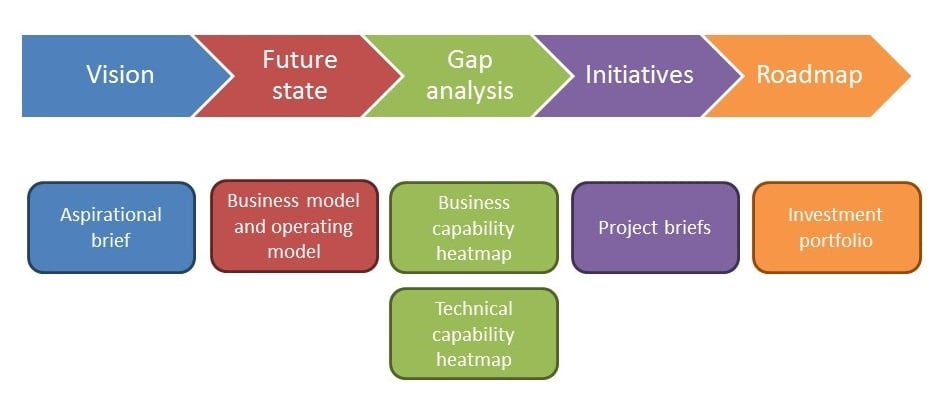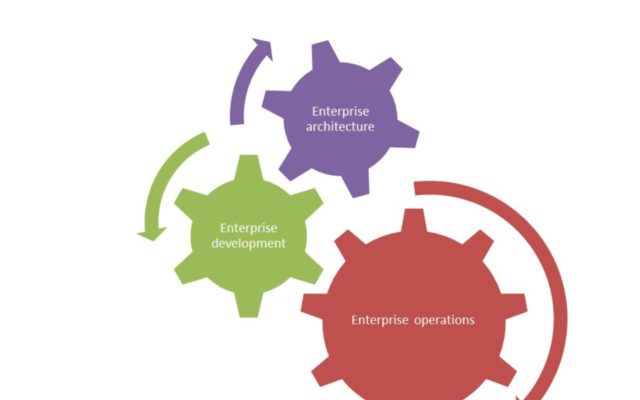In a recent article, I used this simple visual to describe my approach to architecting enterprises. As you can see, it starts with a vision and ends with a roadmap for realising the vision.

This attracted significant comment from a number of colleagues, prompting reflection on my approach, the communication of my approach and the visual aids that I use in explaining my approach to those with whom I engage.
Genesis
Let me start by describing the genesis and motivations for creating and using this visual. In engagement with an enterprise, an early task is to outline to the Executive the journey that we will be jointly undertaking so that they have a sense of how we will realise the intended outcomes of the engagement. This diagram is the result of multiple refinements of that visual and is often customised to reflect the particular language and position of the organisation on this journey.
In a recent assignment, the organisation had done significant work on a “strategy cascade”. As the Executive sponsor and I talked through their cascade, we were able to determine that it encompassed the main elements of vision and business model, such that the “entry point” for this organisation would be with an initial operating model they had developed, seeking to refine it to a point where it would provide input into their annual capital budgeting process.
As it turned out, I became aware during the process that the budgeting process was well in train, even before we started this journey, such that we started describing our activity to those engaged as an assurance process – providing another view on the organisation, the capabilities that they needed to realise their intended business model and their intended differentiated positioning in the markets in which they operated.
In another assignment, the starting point was an “aspirational brief” which had been developed as part of a co-design undertaking by the enterprise and their customers. That is, in fact, how that artefact came to become part of this visual.
In many assignments, the journey ends up being different than indicated by this simple graphic – but that is only known in reflecting back on the journey, which has been an adaptive experience, determining the activities in the course of discovering the new possibilities that might be pursued in iterating through development or refinement of their business model(s) and operating model. It is important, though, to provide a simple representation and to let the journey unfold – any more complex representation becomes confusing and difficult to explain, without greater appreciation of “what is to come”. That is a critical point – my colleagues know “what is to come” because they have been on this journey many times, but often this is the first time for my clients and they need to be afforded the opportunity to discover and shape the most appropriate path for their enterprise.
Disrupted world
In the last forty years (my working life), the world and the working world have changed radically. It was common, in my early working life, to encounter a planning process which essentially entailed forming a vision for where the enterprise wished to be in five to ten years and developing a plan for “getting there”. And to a fair degree, this worked.
Turn the clock forward, and it no longer works! Why not? Because by the time the plan is executed, the world has changed so that the vision is no longer relevant or appropriate. In fact, the vision may entail a range of operating assumptions that are simply no longer valid. This change is reflected in expressions such as market disruption and business model disruption. Markets are changing rapidly, with new entrants bringing new business models and new ways of thinking and operating that can totally undermine the business model of an organisation. I am sure I don’t have to reference the oft-quoted enterprises or industries in which we have seen these changes occur.
Hence, the disrupted world can mean that our visions are no longer relevant or if relevant may be subject to radical disruption within the next five to ten years. In this respect, establishing and creating a vision for our organisation has become an ineffective approach to planning, architecting and designing. This can lead to developing a vision of our organisation as opposed to a vision of the world in which it will be operating. But that, too, might not be reflective of the manner in which our organisation has adapted and evolved in a change world.
Yet, we need some ongoing expression of the enterprise we are pursuing and the motivations underpinning our enterprise. If a vision is not suitable, how do we express our purpose and motivation?
Corporate lifecycle
Taking a slightly different angle, I have found “Managing Corporate Lifecycles” by Ichak Adizes offers a range of valuable insights into the architecting and developing of organisations. Adizes speaks of four key dimensions through the acronym PAEI:
- Purposeful
- Administrative
- Entrepreneurial
- Integrated
He speaks of each of these coming to the fore at different stages in the lifecycle of an organisation and offers an “optimal path”, which takes a balanced approach to each of these dimensions. Elements of this thinking are reflected in several of my articles, including one on enterprise integration and wholeness.
Reflecting on his book takes my mind to thinking about:
- Enterprise integration
- Enterprise and personal integrity
- Enterprise completeness
- Enterprise and personal fulfillment
- Enterprise and personal awareness
All of these require some sense of purpose and may entail some vision of the enterprise and people we aspire to be.
Evolving purpose
Another line of thinking that has been influential for me has been Ackoff’s classification of systems which revolves around the concept of being purposeful. Ackoff defines this as any entity which is able to change either of the means or the ends by which the entity operates. This is a key element of strategic planning and its use of the concept of capability, where exploration occurs in relation to:
- the new markets (ends) which may be pursued with existing capabilities (means)
- the new capabilities (means) which might be required within existing markets (ends)
Ackoff classifies systems in terms of whether their parts are purposeful / non purposeful and the whole is purposeful / non purposeful, naming the systems with purposeful parts and whole as social systems (since it is the people element which brings the social construct of purpose to this purposefulness).
As you would appreciate, when we explore using existing capabilities to pursue new markets, we are exploring new purposes for our existing capabilities. Hence, the need to be flexible (and alert) when exploring strategic directions, seeking to shape our future and potentially change the purposes of our organisation.
Evolving architecture, development and enterprise
It seems to me that the development and sustainment of successful enterprises engages us in evolving our purpose and hence the expression of the enterprise that our organisation is pursuing.
As we evolve our enterprise, we must equally evolve the way in which our enterprise develops, and accordingly, must also evolve the way in which we architect and design our enterprise.
Approaches to architecting enterprises inevitably engage in envisioning the future environment in which they will operate and the way in which they will operate in such environments. It is incumbent on all of us who are involved in leading, architecting, designing, developing and sustaining enterprises that we appreciate the manner in which vision and purpose must evolve and be balanced and adaptable.
As we pursue these activities, we may express our vision and purpose for our enterprise, for our development and for the manner in which we architect and design our enterprise.
Genetics
Hopefully, then, it will come as no surprise to consider that we are genetically wired to be enterprising. I am sure there are authors and thinkers I could reference here! My simplistic view is that being enterprising helped us when we were hunters and gatherers, recognising that collectively we could achieve more than individually. It has helped us through each of the ages – agricultural, industrial, and information / knowledge age. Our enterprising capacity has enhanced our capability to survive and has been further concentrated through our ongoing evolution.
Our enterprising nature has enabled us to develop envision, shape and realise our future, to evolve our visions and our expressions of purpose and to pursue these evolving visions and purposes.
Our enterprising nature enables us to design and realise purposeful organisations, able to give attention to changing the means or changing the ends as we sense and respond to the environment in which we operate.
Conclusion
Perhaps visions and purposes are means and not just ends? Perhaps they are helpful if we appreciate and use them in an adaptive manner as an instrument for conceiving of possible futures and evolving our capacity to realise these futures in a rapidly changing world?
Food for further thought and reflection!
Article by channel:
Everything you need to know about Digital Transformation
The best articles, news and events direct to your inbox
Read more articles tagged: Featured, Operating Model







